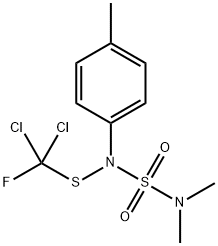
TOLYLFLUANID
- русский язык имя
- английское имяTOLYLFLUANID
- CAS №731-27-1
- CBNumberCB3438572
- ФормулаC10H13Cl2FN2O2S2
- мольный вес347.26
- EINECS211-986-9
- номер MDLMFCD00055477
- файл Mol731-27-1.mol
| Температура плавления | 96°C |
| Температура кипения | 93℃ |
| плотность | 1.5132 (rough estimate) |
| давление пара | 2 x 10-5 Pa (20 °C) |
| показатель преломления | 1.6000 (estimate) |
| температура хранения | -20°C |
| растворимость | soluble in DMSO, Methanol |
| Растворимость в воде | 0.9 mg l-1 (20 °C) |
| пка | -5.06±0.50(Predicted) |
| Цветовой индекс | 45430 |
| БРН | 2949607 |
| LogP | 3.900 |
| Рейтинг продуктов питания EWG | 2 |
| FDA UNII | 382277YXSG |
| Система регистрации веществ EPA | Tolylfluanid (731-27-1) |
| UNSPSC Code | 41116107 |
| NACRES | NA.24 |
| Коды опасности | T,N,T+ |
| Заявления о рисках | 23-36/37/38-43-48/20-50/53-50-48/23-26 |
| Заявления о безопасности | 24-26-37-38-45-60-61-63-36/37/39-28 |
| РИДАДР | 2588 |
| WGK Германия | 3 |
| RTECS | WO6560000 |
| Класс опасности | 6.1(b) |
| Группа упаковки | III |
| Банк данных об опасных веществах | 731-27-1(Hazardous Substances Data) |
рисовальное письмо(GHS)
-
рисовальное письмо(GHS)



-
сигнальный язык
опасность
-
вредная бумага
H315:При попадании на кожу вызывает раздражение.
H319:При попадании в глаза вызывает выраженное раздражение.
H335:Может вызывать раздражение верхних дыхательных путей.
H317:При контакте с кожей может вызывать аллергическую реакцию.
H372:Поражает органы в результате многократного или продолжительного воздействия.
H400:Чрезвычайно токсично для водных организмов.
H330:Смертельно при вдыхании.
-
оператор предупредительных мер
P273:Избегать попадания в окружающую среду.
P280:Использовать перчатки/ средства защиты глаз/ лица.
P302+P352:ПРИ ПОПАДАНИИ НА КОЖУ: Промыть большим количеством воды.
P304+P340+P310:ПРИ ВДЫХАНИИ: Свежий воздух, покой. Немедленно обратиться за медицинской помощью.
P305+P351+P338:ПРИ ПОПАДАНИИ В ГЛАЗА: Осторожно промыть глаза водой в течение нескольких минут. Снять контактные линзы, если Вы ими пользуетесь и если это легко сделать. Продолжить промывание глаз.
P314:В случае плохого самочувствия обратиться к врачу.
TOLYLFLUANID химические свойства, назначение, производство
Использование
Tolylfluanid is used to control a wide range of fungal diseases on apples, grapes, strawberries and other fruit and storage diseases on many crops.Определение
ChEBI: A member of the class of sulfamides that is dichlofluanid in which the hydrogen at the para position of the phenyl group is replaced by a methyl group. A fungicide first marketed in 1971 and used in the cultivation of fruit and vegetables, as ell as in wood preservatives, it is no longer approved for use in the European Union.Метаболический путь
Tolylfluanid contains an unstable dichlorofluoromethylthio (sulfenyl) moiety that has been shown to undergo rapid hydrolytic and metabolic degradation to dimethylaminosulfotoluidide (2). By analogy with captan, presumably the dichlorofluoromethylthio moiety can be transferred to the sulfur atoms of cellular thiols such as cysteine and glutathione. Thus, in the presence of thiols tolylfluanid is probably cleaved at the N-S bond to form thiophosgene or its monofluoro analogue (3) and other gaseous products such as hydrogen sulfide, hydrogen chloride and carbonyl sulfide. Thiophosgene or its monofluoro analogue is rapidly hydrolysed by water. The dichlorofluoromethylthio group and thiophosgene may be intermediates in the formation of addition products, for example addition to cysteine affords thiazolidine-2-thione-4-carboxylica cid (4). A thiazolidine derivative of glutathione may also be formed. The main metabolic reactions in all media were cleavage of the N-S bond to give dimethylaminosulfotoluidide (2) followed by hydroxylation of the phenyl ring and oxidation of the methyl substituent on the phenyl ring. Glucoside conjugates were detected in plants and the cysteine adduct, thiazolidine-2- thione-4-carboxylic acid (4), was formed in rats.TOLYLFLUANID поставщик
| поставщик | телефон | страна | номенклатура продукции | благоприятные условия |
|---|---|---|---|---|
| 18871490254 | CHINA | 28172 | 58 | |
| +86-023-6139-8061 +86-86-13650506873 |
China | 39894 | 58 | |
| +86-89586680 +86-13289823923 |
China | 8670 | 58 | |
| +86-057181025280; +8617767106207 |
China | 49734 | 58 | |
| +86-0512-83500002 +8615195660023 |
China | 23046 | 58 | |
| +86-852-30606658 | China | 43340 | 58 | |
| +86-18621343501; +undefined18621343501 |
China | 33338 | 58 | |
| +8613817748580 | China | 40066 | 58 | |
| +8618950047208 | China | 43416 | 58 | |
| 010-82848833 400-666-7788 |
China | 96815 | 76 |